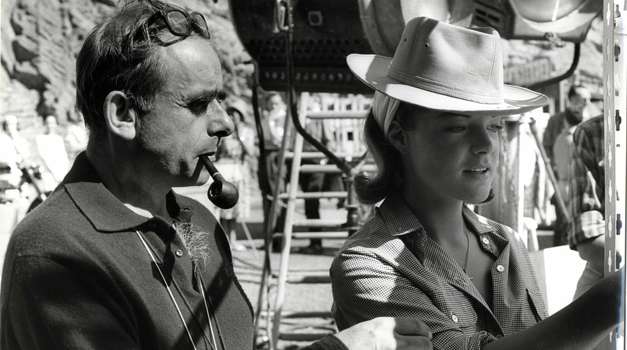[Serge Bomberg, Ruxandra Medea:
Henri-Georges Clouzot's Inferno/L'Infer d'Henri Georges Clouzot (2009)]
 CLOUZOT AND SCHNEIDER DURING THE SHOOTING OF L'INFERAnatomy of an elaborate unfinished productionL'Enfer d'Henri-Georges Clouzot
CLOUZOT AND SCHNEIDER DURING THE SHOOTING OF L'INFERAnatomy of an elaborate unfinished productionL'Enfer d'Henri-Georges Clouzot is one of those documentaries, like Fulton and Pepe's
Lost in La Mancha, about a movie that never got finished. This one concerns a film of 1964. Not a suspense thriller like the director's famous
Wages of Fear (1953) or
Diabolique (1955), which gained him arthouse notoriety in the States and made him seem a French competitor of Hitchcock, or his earlier detective meller masterpiece
Quai des Orfevres (1947),
Inferno was a psychological study of jealousy, with Serge Reggiani as stricken husband Marcel and the young, but already stellar, Romi Schneider as his too-pretty, flirtatious wife, Odette (references to Proust?). But things got too complicated and the movie never happened.
In 1994, Claude Chabrol did his version of the story, having purchased the script from Clouzot's widow, Inez. In both cases, the essence of the tale is that the hotel owner's suspicions lead to paranoid delusions that overpower him. But Chabrol represents one of the primary
Cahiers du Cinema branch of the French Nouvelle Vague, which was at its peak during the period of Clouzot's ascendancy, but represented new, freer, more inventive ways of working in film.
Clouzot on the contrary was old school, and was particularly noted for writing and story-boarding everything out ahead of time in the most scrupulous detail, as well as for working actors too hard. His
Inferno was to have been highly inventive in one respect, at least: he shot reams of experimental, "op-art" and prismatic lens shots, even creating "optical coitus" with spinning geometry and a zoom lens, as well as on-location reverse color images, planning visual equivalents of the Reggiani character's growing madness. The latest techniques were used, though the concept seems rather more like the surrealism of the Forties and Fifties than something new.
Still, there's no way of knowing how well the film would have turned out. What is clear is that those experimental shoots took too long, and ate up funds as well as time. When it went beyond pure optical illusion in the studio and more and more required the participation of Reggiani and Schneider, the shooting, much of it extraneous to the script, began to strain the stars as well. Clouzot was a chronic insomniac and would wake crew members at two a.m. with new ideas. He made Reggiani spend an entire day running, shooting the same sequence over and over and exhausting him. Reggiani walked off the set, pleading a mysterious illness, and never came back. Jean-Louis Tritignant was called in to interview as a replacement, but that didn't work out. Shortly later Clouzot, then 56, had a heart attack. That was it. Clouzot only made one more film,
La Prisonniere, and died in 1977, aged 70.
Because the film wasn't finished, all the "preuves" were kept, and this film is interesting and unique for its lavish sampling of the experimental footage in which day-glo images spiral hypnotically or Marcek or his (imagined?) rival's faces merge, or Reggiani's or Schneider's faces are distorted as in a fun house. There's also detailed footage showing work to use color reversal to make the lake of the setting turn red when Marcel sees Odette water-skiing with Martineau (Jean-Claude Bercq), the local womanizer with whom she apparently has a fling.
The trick as Bomberg, a specilalist in cinematic history and film restoration, told it in a NYFF Q&A, was to get hold of the 185 cans of footage controlled by Clouzot's second wife, Inez. Getting caught in a stalled elevator for two hours with her convinced her that her experience with Bomberg was "special" enough to give him the rights she'd denied to many others, and she also passed the completed documentary, without cuts.
The
Inferno footage is largely without sound, though there are test recordings of Reggiani uttering mad repetitious ravings as the wacked-out Marcel. Bomberg uses voice-overs to reconstruct some scenes of the film, and introduces five short scenes in which conetemporary actors Berenice Bejo and Jacques Gamblin read from the script, to extrapolate.
Though it's all a bit after-the-fact, and the value of the Clouzot film remains moot, the documentary has interviews with nine cast and crew members, including Catherine Allegret, then-production assistant Costa Gavras and assistant cinematographer William Lubtchansky. Details of the breakdown emerge, and it's due to Clouzot's employing three separate film crews unaware of each other's activities, and his endless re-shooting of simple sequences. As one talking head points out, the film might have gotten made if Clouzot hadn't been writer, director, and producer. A real producer might have speeded things up, thus saving everybody's nerves and the production.
This is a glossy, beautifully crafted MK2 production and is a must-see for film buffs, particularly those interested in French cinema history. However as
Variety reviewer Todd McCarthy
points out, essential context is omitted in the failure to mention Clouzot's being out of commission throughout the Thirties in sanatoriums for mental problems. Maybe the widow wouldn't have wanted his lack of mental balance to be further discussed. McCarthy is also right that the dominant image you come away with is the radiant and obviously cooperative young Romi Schneider. Dany Carrel as "Marylou" is another pert sex kitten in the cast who shows off plenty for the camera. It's puzzling that in the Q&A the flamboyant but otherwise informative Bomberg (so chatty he who was reluctant to relinquish the mike both before and after the NYFF public screening), never once mentioned co-director Ruxandra Medrea. Anyway, this is a rich and evocative piece of cinematic documentation.
Shown as part of the New York Film Festival at Lincoln Center 2009. Also featured at Cannes, Toronto, Vancouver, and the London Film Festival. To open in France November 11, 2009.





